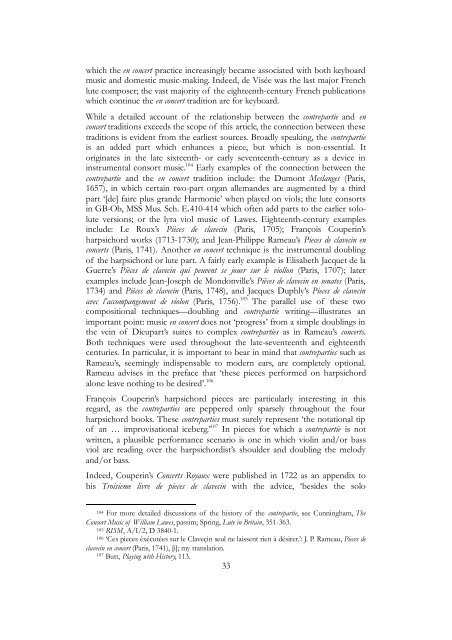Partiturbuch Ludwig - The Viola da Gamba Society
Partiturbuch Ludwig - The Viola da Gamba Society
Partiturbuch Ludwig - The Viola da Gamba Society
Create successful ePaper yourself
Turn your PDF publications into a flip-book with our unique Google optimized e-Paper software.
which the en concert practice increasingly became associated with both keyboard<br />
music and domestic music-making. Indeed, de Visée was the last major French<br />
lute composer; the vast majority of the eighteenth-century French publications<br />
which continue the en concert tradition are for keyboard.<br />
While a detailed account of the relationship between the contrepartie and en<br />
concert traditions exceeds the scope of this article, the connection between these<br />
traditions is evident from the earliest sources. Broadly speaking, the contrepartie<br />
is an added part which enhances a piece, but which is non-essential. It<br />
originates in the late sixteenth- or early seventeenth-century as a device in<br />
instrumental consort music. 104 Early examples of the connection between the<br />
contrepartie and the en concert tradition include: the Dumont Meslanges (Paris,<br />
1657), in which certain two-part organ allemandes are augmented by a third<br />
part ‘[de] faire plus grande Harmonie’ when played on viols; the lute consorts<br />
in GB-Ob, MSS Mus. Sch. E.410-414 which often add parts to the earlier sololute<br />
versions; or the lyra viol music of Lawes. Eighteenth-century examples<br />
include: Le Roux’s Pièces de clavecin (Paris, 1705); François Couperin’s<br />
harpsichord works (1713-1730); and Jean-Philippe Rameau’s Pieces de clavecin en<br />
concerts (Paris, 1741). Another en concert technique is the instrumental doubling<br />
of the harpsichord or lute part. A fairly early example is Elisabeth Jacquet de la<br />
Guerre’s Pièces de clavecin qui peuvent se jouer sur le viollon (Paris, 1707); later<br />
examples include Jean-Joseph de Mondonville’s Pièces de clavecin en sonates (Paris,<br />
1734) and Pièces de clavecin (Paris, 1748), and Jacques Duphly’s Pieces de clavecin<br />
avec l’accompangement de violon (Paris, 1756). 105 <strong>The</strong> parallel use of these two<br />
compositional techniques—doubling and contrepartie writing—illustrates an<br />
important point: music en concert does not ‘progress’ from a simple doublings in<br />
the vein of Dieupart’s suites to complex contreparties as in Rameau’s concerts.<br />
Both techniques were used throughout the late-seventeenth and eighteenth<br />
centuries. In particular, it is important to bear in mind that contreparties such as<br />
Rameau’s, seemingly indispensable to modern ears, are completely optional.<br />
Rameau advises in the preface that ‘these pieces performed on harpsichord<br />
alone leave nothing to be desired’. 106<br />
François Couperin’s harpsichord pieces are particularly interesting in this<br />
regard, as the contreparties are peppered only sparsely throughout the four<br />
harpsichord books. <strong>The</strong>se contreparties must surely represent ‘the notational tip<br />
of an … improvisational iceberg.’ 107 In pieces for which a contrepartie is not<br />
written, a plausible performance scenario is one in which violin and/or bass<br />
viol are reading over the harpsichordist’s shoulder and doubling the melody<br />
and/or bass.<br />
Indeed, Couperin’s Concerts Royaux were published in 1722 as an appendix to<br />
his Troisieme livre de pieces de clavecin with the advice, ‘besides the solo<br />
104 For more detailed discussions of the history of the contrepartie, see Cunningham, <strong>The</strong><br />
Consort Music of William Lawes, passim; Spring, Lute in Britain, 351-363.<br />
105 RISM, A/I/2, D 3840-1.<br />
106 ‘Ces pieces éxécutées sur le Claveçin seul ne laissent rien à désirer.’: J. P. Rameau, Pieces de<br />
clavecin en concert (Paris, 1741), [i]; my translation.<br />
107 Butt, Playing with History, 113.<br />
33

















